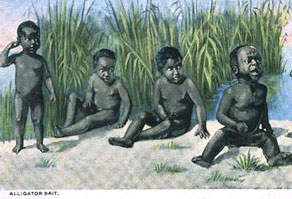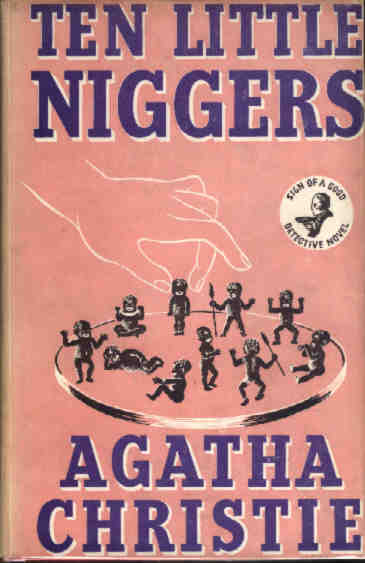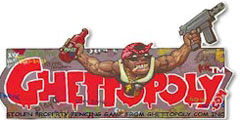Jim Crow Propaganda

Last week I was invited to give a talk about free speech at Ferris State University in Michigan. Much to my pleasure, I discovered that one of the professors at Ferris is an old colleague, Dennis Ruzicka, who was a fellow reporter 20 years ago when we both worked for a small-town, daily newspaper in Wisconsin.
After the talk, Dennis showed me around the campus. One of our most fascinating stops was the "Jim Crow Museum of Racist Memorabilia" that has been assembled by sociology professor David Pilgrim. The Jim Crow Museum contains more than 2,000 racist artifacts, dating from pre-Civil War days to the present: cartoons, Sambo masks, Coon toys, Picaninny ashtrays, Ku Klux Klan literature, postcards with Black children portrayed as "alligator bait."
"All racial groups have been caricatured in this country, but none have been caricatured as often or in as many ways as have black Americans," Pilgrim writes. "Blacks have been portrayed in popular culture as pitiable exotics, cannibalistic savages, hypersexual deviants, childlike buffoons, obedient servants, self-loathing victims, and menaces to society. These anti-black depictions were routinely manifested in or on material objects: ashtrays, drinking glasses, banks, games, fishing lures, detergent boxes, and other everyday items. These objects, with racist representations, both reflected and shaped attitudes towards African Americans. Robbin Henderson, director of the Berkeley Art Center, said, 'derogatory imagery enables people to absorb stereotypes; which in turn allows them to ignore and condone injustice, discrimination, segregation, and racism.' She was right. Racist imagery is propaganda and that propaganda was used to support Jim Crow laws and customs."

A frequently asked questions page on the museum's website acknowledges that many people will find its artifacts offensive. "They were meant to be offensive," it observes. "They were meant to humiliate. They were used to buttress Jim Crow laws and Jim Crow etiquette." However, the purpose of the museum is not to offend but "to educate visitors about race relations in the United States. ... We believe that these items must be viewed and understood without sugar coating."

One of the surprises I encountered while browsing the displays was a copy of Ten Little Niggers, which I discovered was the original title of Agatha Christie's best-selling novel (subsequently renamed to Ten Little Indians and later to And Then There Were None). Christie's book is regarded by some as the best mystery novel ever written, and its changing title makes for quite a story all by itself. "Ten Little Indians" was originally the title of a comic song written in the 1860s by Philadelphia songwriter Septimus Winner. The song made its way to England, where another songwriter named Frank Green adapted it for use in a Victorian minstrel show, giving it new lyrics and changing "Indians" to "Niggers." In each stanza of the lyrics, one of the little niggers disappears through a different cause: "One choked his little self and then there were nine. ... One overslept himself and then there were eight. ... One said he'd stay there and then there were seven. ... One chopped himself in halves and then there were six."
Christie liked to use nursery songs for her titles, and by the time she wrote Ten Little Niggers in 1939, Green's version had become a popular children's song in the United Kingdom. Her story follows a plot similar to the song, as a series of murders are committed using methods that echo its lyrics. In later editions, however, the publisher decided that the original title could be construed as racially offensive and retitled it, also changing some of the wording of the story to soften the racial references.

Other exhibits at the Jim Crow Museum show racial stereotyping that is more subtle. For example, the image of Aunt Jemima, a fictional character whose face appears to this day on boxes of pancake mix, beams with maternal benevolence, and over the years advertisers have given her image a makeover, lightening her skin and eliminating the bandana that she used to wear. However, she remains an example of the "mammy" stereotype that has been used in advertisements for household items including foods, detergents, planters, ashtrays, sewing accessories, and beverages.
Viewing these images can be disturbing and enlightening at the same time, and Ferris State University is providing a public service by making them available. The Jim Crow Museum is worth studying for anyone who wants to understand propaganda, and it remains relevant today. Although overt racism is less acceptable today than it was in the past, the museum includes many recently-created items, often with a harder, more hostile edge than its older items. Whereas blacks used to be portrayed as exotic, foolish and childlike, today they are portrayed as menacing, gun-toting drug addicts or as hypersexual pimps and whores. Examples include the following:
-
 Artwork for the "Ghettopoly" board game.
Artwork for the "Ghettopoly" board game.Ghettopoly is a board game modeled after Monopoly, except that it belittles racial minorities. Ghettopoly has seven game pieces: Pimp, Hoe, 40 oz, Machine Gun, Marijuana Leaf, Basketball, and Crack. One of the game's cards reads, "You got yo whole neighborhood addicted to crack. Collect $50 from each playa." Whereas Monopoly has houses and hotels, Ghettopoly has crack houses and projects.
- Trash Talker Dolls, distributed by AdultDolls.net, sells dolls that stereotype various ethnic groups. Their best seller is Pimp Daddy, a chain-wearing black man who says, among other things, "You better make some money, bitch."
- The minstrel show is back too, in the person of Charles Knipp, a white man who gives performances—popular in the deep South—in which he dresses up in ragged women's clothes and blackface makeup and portrays "Shirley Q. Liquor," a trash-talking black woman with 19 children.
According to David Pilgrim,
The new racial climate is marked by ambivalence and contradiction. Most polls about race show a decline in prejudice among whites. There remains a heightened sense that racism is wrong and that tolerating 'racial others' is good; however, there is a growing acceptance of ideas critical of and belittling toward blacks and other minorities. ...
In the early 1990s I attended an academic conference in New Orleans. I searched local stores for racist objects. There were not many. Ten years later I returned to New Orleans. I found anti-black objects in many stores. This is disappointing but not surprising. Brutally racist items are readily available through Internet auction houses, most notably, eBay. Indeed, practically every item housed in the Jim Crow Museum is being sold on some Internet site. Old racist items are being reproduced and new items are being created. Each year, Halloween USA produces monster masks by exaggerating the features of Africans and African Americans.
More recently, of course, other images have been coming out of New Orleans, also imbued with racial meanings. Controversy has arisen, for example, about the contrast between news photographs of Hurricane Katrina—one with a caption that described white people "finding bread and soda from a local grocery store," while the caption to a photo of a black man carrying similar supplies stated that he had been "looting a grocery store." Other controversy followed the remarks of rapper Kanye West, when he departed from scripted comments during a Katrina fundraiser and complained that "America is set up to help the poor, the black people, the less well-off, as slow as possible. ... George Bush doesn't care about black people."
According to the Gallup polling company, "Whites and blacks have sharply differing reactions to the federal government's response to Hurricane Katrina, with blacks more likely than whites to believe that racial bias was a factor in slowing the government's response, and blacks especially critical of President Bush's performance." If we want to understand what accounts for these differing perceptions, a visit to the Jim Crow Museum may help provide some of the answers.





Comments
Jim Crow legacy
May I recommend The Mammy Project at themammyproject.com
*
The Mammy Project written and performed by Michelle Matlock is an original work made up of a series of monologues which explores the influence that the stereotype, myth and icon of “Mammy” has had on contemporary American culture.
*
The Mammy Project Weaves the untold history of Nancy Green, the first African-American woman hired to play the part of ‘Aunt Jemima’ at the 1893 World’s Fair in Chicago with African-American Activist’ like Ida B. Wells, struggle to have black people represented at the very same World’s Fair.
*
The Mammy Project uses original music, storytelling and historical speeches by Frederick Douglas and Halle Q. Brown to transform an oppressive stereotype into a celebration of the power we gain from knowing and understanding our history.
*
Michelle Matlock, a character actress and physical comedienne digs deep into her own experience, imagination and American history to deliver a personal, political and entertaining exposé.
Strange...
This is a bullshit! How it's possible to make such things? Most of all I am interested by how it is possible to reduce racist relation of people distributing or even encouraging such creation of things? And one business if I shall buy such thing on EBay for a collecting but absolutely other - to see every day such on a liquid for washing utensils or on a box with milk. It seems to me that not art and really pure racism. Probably it is infinite, as well as is silly. Unfortunately: (
With best wishes, "Russian Post"
We are always .online for help
[http://www.xnetdot.com Xnet RusPost]
The Deep South???
"Morning Edition, September 27, 2005 · The FBI is investigating a series of cross burnings in the Detroit area. The burning crosses were among the symbols of intimidation used by segregationists during the civil rights era. Now they are part of a rash of hate crimes in a region long separated by race. Detroit Public Radio's Quinn Klinefelter reports." http://www.npr.org/templates/story/story.php?storyId=4865351
I wonder why so much of the discussion nof race in America centers on the "deep south." If the "series of cross burnings in the Detroit area" was happening in the Birmingham area or any other "deep south" area it would be national news, CNN Faux News, MSNBC etc...but since it is occurring in one of if not the most racially segregated areas of the country it only ranks a blip on NPR.
I am from the deep south and I do know serious racsist but I have never seen racism, hate and ignorance to rival that of the Ohio River Valley area around Cincinnati, OH which is definitley not the deep south,but is also home to a recent rend of cross burnings which lead to several arrests, so it is time for the discussion of Race and Racism in america to move beyond the shadows of history and into the present. Fetishizing the former propagandanistic images of Jim Crow without talking about the real locations of division in the country is merely an academic exercise.
"Former"?
I agree that racism is not limited to the "deep south" and that there ought to be more discussion of race issues such as the situation you're describing in Detroit. However, my original article didn't limit itself to a discussion of racism only in the deep south. For example, it discussed Agatha Christie's novel, Ten Little Niggers. Christie was British, and the title of her book was taken from a children's song popular in England. That's not only outside the deep south but outside the United States.
I'd also take issue with your suggestion that my article is "fetishizing the former propagandistic images of Jim Crow." There's nothing "former" about this stuff. As current examples like "Ghettopoly" demonstrate, propaganda of this type is still being produced.
popular in the deep south?
yep, popular in the deep South
Logic and prejudice
Anyway, Toronto, Boston and Pittsburgh now qualify as "deep South"? And Austin, New Orleans, Ft. Lauderdale and Tampa/Clearwater (their latitude notwithstanding)? At best your list is 50/50. Not that it matters since your syllogism is incomplete to begin with.
I respectfully suggest that you and your sociologist pal [a] take a course in basic logic and [b] examine your own ignorant prejudices.
Aunt Jemima
Although Aunt Jemima was a fictional character,
she wasn't just a face on a box. She was played by
actual women including, Brown County, Ohio native
Rose Washington Parks,1901-1969, during the 1950s.
This story was published 01/16/2001 in the Ledger
Independent in Maysville, Ky.
Rosa Washington Riles -- Aunt Jemima born in Brown County
By T. J. TUCKER
Staff Writer
Aunt Jemima www.ripleyk.12.oh.us/ripley/historicripley/aunt_jemima.htm.
Rosa Washington Riles, better known as "Aunt Jemima" was one of Brown County's most noted but least known natives. Although, the character of Aunt Jemima has been often criticized for its stereotypical portrayal of African-Americans, Rosa remains one of Brown County's most beloved daughters.
"Aunt Jemima" was born in 1901 as Rosa Washington near Red Oak, Brown County, Ohio. She was one of several children of Robert and Julie (Holliday) Washington and a grand-daughter of George and Phoeba Washington, all of whom, like her, are buried in the Red Oak Presbyterian Graveyard somewhat south of her birthplace. She died in 1969.
Rosa became "Aunt Jemima" in the 1950's. She was employed as a cook in the home of a Quaker Oats executive and went out for pancake demonstrations at her employer's request. This was following the death of Nancy Green, the former Aunt Jemima. The portrait of Rosa Washington showed a smiling, laughing, good-humored face that brought instant thoughts of delicious goodies and the anticipation of the stomach warming excellence of steaming hot pancakes smothered with fresh butter and maple syrup.
Rosa rose to fame because of her jovial personality, which so readily won fans and friends as she toured the United States annually giving her demonstrations. She often would do demonstrations in Ripley and Georgetown.
In the beginning of Rosa Washington's career as Aunt Jemima, the pancake mix was packaged and sold in one-pound covered cardboard cartons. At that period her portrait covered one entire side of the carton. Later redesigning of the packages reduced her portrait to a silver-dollar sized medallion in the upper left corner of the side of the box, and that is exactly how it can be found on the store shelves yet today. During the well advertised and well attended demonstrations, Aunt Jemima also promoted Log Cabin Syrup and Ball's Milk.
At various times along the way, advertising "gimmicks" such as salt and pepper shakers, penny banks and rag dolls were produced - all in the easily recognized form of the chubby Aunt Jemima.
Today, a collection of Aunt Jemima souvenirs and collector's items can be found at the Red Oak Church.
The late Glen Woods of Russellville, Ohio, gave this collection to the church in recognition of what Aunt Jemima had contributed to the people of the United States.
In honor of Aunt Jemima, an annual pancake breakfast is held at the church. The proceeds are used for the upkeep of the old part of the cemetery next to the church. Those attending often visit the grave of Rosa and reflect upon her life and its importance. She so successfully concealed her greatness, that few today who pass rapidly along the Ripley-Russellville Pike (Route 62/68) realize that the birth site and burial place of "Aunt Jemima" can be seen from that highway.
Her daughter, Mrs. Ruth Sugg, who lives in Cincinnati travels from home to Red Oak every Memorial Day and Christmas to place flowers on the graves of her mother, her brothers and her grandparents and great-grand-parents.
(From research papers of the late Glenn Woods recorded on Ripley's Web site at www.ripleyk.12.oh.us/ripley/historicripley/aunt_jemima.htm.).